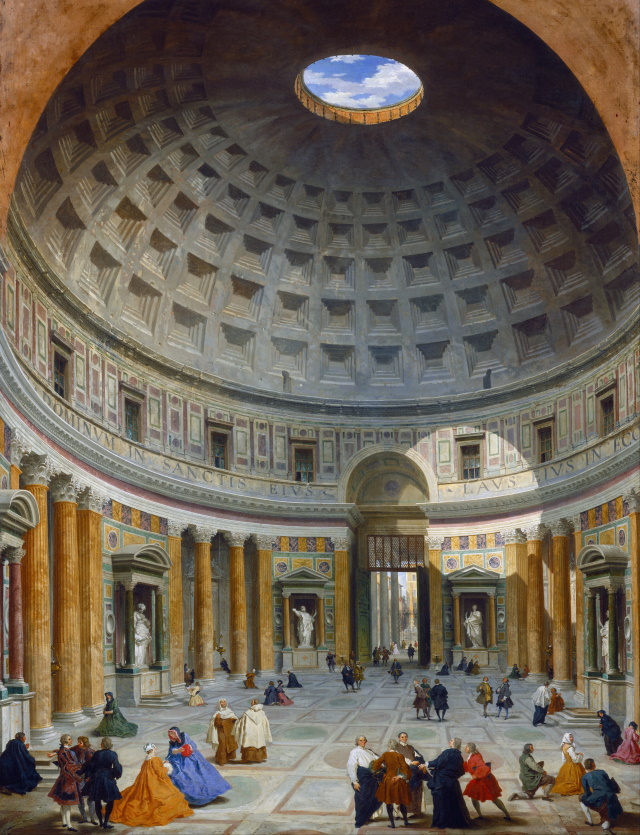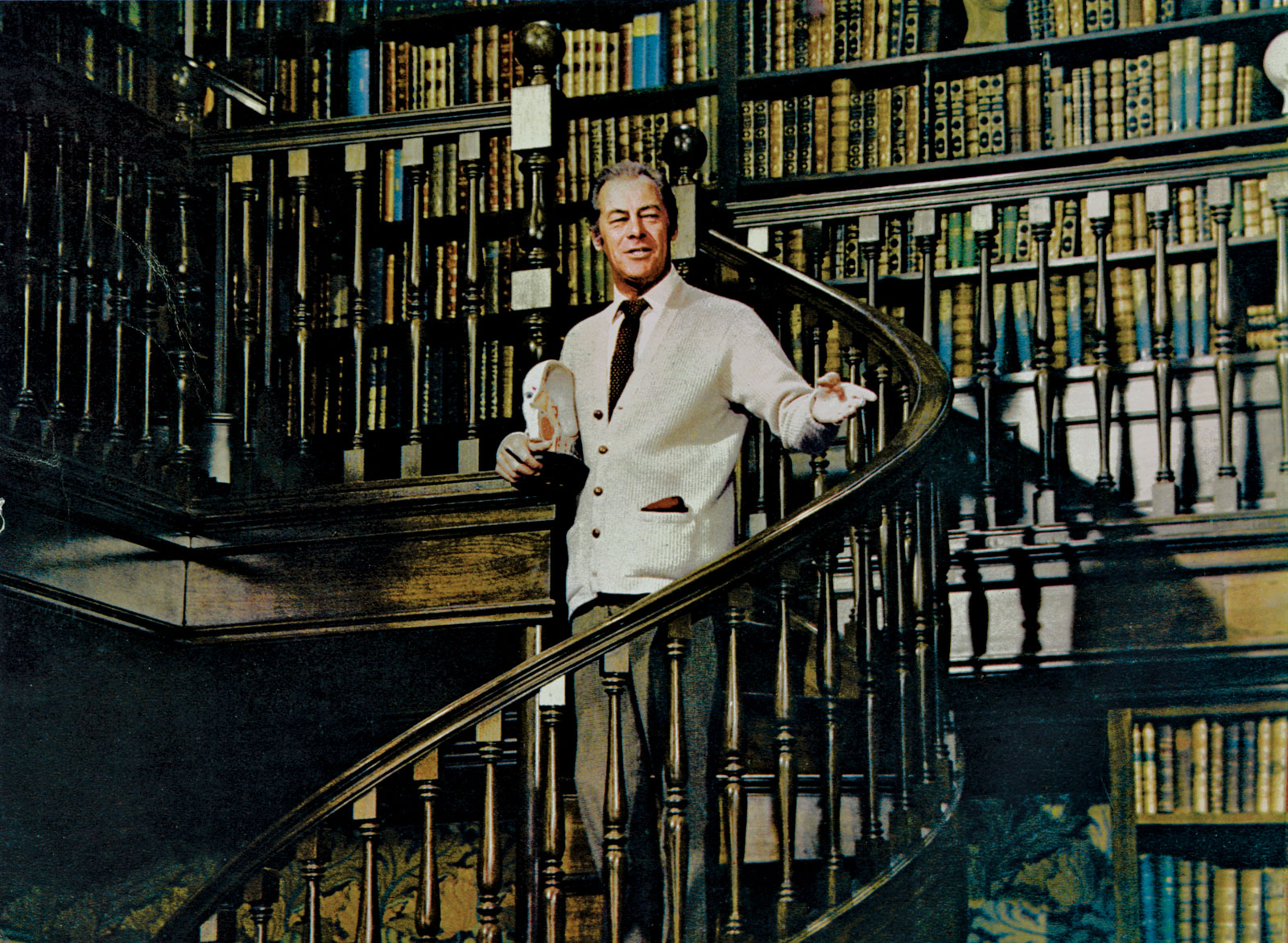Scaffolding Magic
There is an abstract recipe from Penn and Teller for how to create an effect that seems magical: use more effort for the effect than the viewer might initially imagine the effect is worth. A viewer seeing the effect will be surprised, amazed, and impressed; the effect seems magical.
There is a story in the "Golden Legend", which is a medieval book about lives of saints, regarding how a particular dome, the Pantheon in Rome, was built. According to this (dubious) story, the dome was built by piling up dirt mixed with coins, and then building the real structure of the dome on top of the dirt. Once the dome was complete, they told people that whoever wanted to come and take away the dirt could keep the coins, and so lots of people came and dug out the dirt.
The historical truth of the legend is not relevant. The point is that it is a colorful and concrete example of the sense of wonder that might be evoked by looking at this huge dome with an eye at the top of it.

The abstract idea of "what if that wondrous effect was created by some sort of massive effort?", and the word "scaffolding" allows you to distance yourself from wonder a little bit and think of at least one possible construction strategy - first bringing, then removing, an enormous pile of dirt. Once you've thought of a strategy, then maybe you can improve on that strategy.
Triangular and Square Jigs for ideas
To the concept of scaffolding, I associate the concept of a jig - a tool in woodworking which is constructed out of the same wood as the eventual product, used, maybe repeatedly in the course of a particular project, and then maybe thrown away but definitely not delivered as part of the product. I am certain there are a lot of abstract ideas that are used analogously appropriate used repeatedly in a particular project, and then thrown away. There are three things that I think of as potentially functioning as "jigs for ideas":
-
Three concepts A, B, C such that "A applied to B results in C" or "A blended with B results in C", with no assumption that "A applied to B" is the same thing as "B applied to A". This corresponds to the "/" operator from Margaret Masterman's NUDE interlingua - some sort of noncommutative conceptual blending. An example might be working from an input output pair to develop a sense of a function that would take that input to that output, or calculating forward from a known function and an input to the corresponding output, or calculating backward from a known function and an output to an input that would provoke that function to that output.
-
Three concepts A, B, C such that "A combined with B results in C" and symmetrically "B combined with A results in C". This corresponds to the ":" operator from Margaret Masterman's NUDE interlingua - some sort of commutative conceptual blending. An example might be working from a few examples to a generalization, or from a concrete thing and a feature of that thing to find another example which is similar but differs in that feature.
-
Four concepts A, B, C, D such that "A is to B as C is to D". A very concrete example is the phonemes /p/ and /b/ are alike in many ways, but differ in voicing, while the phonemes /t/ and /d/ are also alike in many ways, and also differ in voicing. The former pair have labal place of articulation, while the latter have alveolar place of articulation. So "/p/ is to /b/ as /t/ is to /d/"
I think the strength of jigs isn't really the triangles or squares, it's reusing one or a few of the elements over and over again to create neat, symmetrical structures.
Parallel texts, Chrestomathy, such as the Proust Questionnaire
There's a practice, in linguistics, of chrestomathy, parallel texts, or aligned texts.
The Rosetta stone is a famous parallel text which helped Champollion translate hieroglyphics. Parallel texts are valuable in programming too. There are programming chrestomathies such as Rosetta Code. Christa Lopes's Exercises in Programming Style is a chrestomathy too; the same task is implemented in Python over and over again, using different styles.
If you are attempting to make a change to a (software) system, adding a feature, and you are unfamiliar with the system, the version control system may support you going to a previous change or several changes that added somewhat similar features. Then you can create your change by completing the parallel text.
There is a variation of this technique which is when you reuse a previous attempt of yours as a model or guide. Maybe you failed at the previous attempt, maybe you scrapped it when it didn't work out, maybe it was executed in a more flexible way without all the constraints (nonfunctional requirements) that the final attempt. I have previously written about this strategy in "Underdrawing".
Using the idea of a Questionnaire to grow
"In 1886, Antoinette Faure, the daughter of the future French President Felix Faure, asked her childhood friend Marcel Proust to fill out a questionnaire in a book titled "Confessions. An Album to Record Thoughts, Feelings, & c." A fashionable parlor game originating among the Victorian literate classes, the "confession album," as it was known, presented a formulaic set of queries on each page - "What is your distinguishing characteristic," for instance, or "What virtue do you most esteem?" The album's owner would pass the volume around among her friends, collecting their comments as a kind of souvenir, not unlike the notes that high-school students leave in one another's yearbooks. Though Proust was only fourteen years old when he filled out Faure's album, he responded to the questionnaire in precociously Proustian style." - https://www.newyorker.com/books/page-turner/how-the-proust-questionnaire-went-from-literary-curio-to-prestige-personality-quiz
Various celebrities, such as David Bowie, have also answered these questions.
The confession album forms a specific sort of parallel text, which can be extended in two natural directions. You can ask the existing questions of a new person, or you can add a question and pass the confession album back to the previous persons.
Let's talk about gradually developing a questionnaire regarding consonants. Put yourself in the place of an early English-phonetics academic, someone like Henry Higgins from "My Fair Lady".

You might hypothesize that there's some similarity between /p/ and /t/, which naturally leads to the question - what is the remaining quality that distinguishes between them? By saying nonsense like 'pee-tee-pee-tee-pee-tee' or 'puh-tuh-puh-tuh-puh-tuh' you can see that there is a location in your mouth which is closed, accumulates pressure behind it, and then explodes open, creating the percussive sound of /p/ and /t/ - but that location is the lips in the case of /p/ and with the tongue touching the teeth or the hard palate in the case of /t/.
In what might be, on the first face of things, a weird order, first there are familiar entities /p/ and /t/ first, and then second there are answers "the lips" and "the hard palate", and then from those there is a concept something like "place of articulation". Now we have two persons (/p/ and /t/) and one question in our questionnaire.
- Place of articulation?
By asking "what is the place of articulation of /b/?" we are extending the confession album by asking the existing questions of a new person. By asking "what distinguishes /p/ and /b/?" we can develop a new question, something like "voiced or voiceless?", and we can revisit our previous persons and ask them this question.
- Place of articulation?
- Voiced or voiceless?
The questions in the book and the structure that the questions put on the familiar persons can be wins, takeaways that justify the attempt to make the confession book. There are other wins.
Another kind of win is "clashes" - you may find that some concepts hang together nicely and can be organized into a scheme, and other concepts don't fit well with that scheme. Clashes are also wins. You can imagine starting with the "pitchy" vowel sounds and trying to extend concepts related to pitch to consonants, and experiencing a clash. The clash allows you discover (or possibly, re-delineate in a different way) the concept of vowels and consonants.
Once there are sufficient examples that we feel pretty secure about what the questions are, we might wield our questionnaire to create novel persons - deliberate conceptual blending with a whole scaffolding of organizing structure behind it. Can you imagine a character who would answer Proust's answer to "greatest misfortune?": "to be separated from Mama" and to other questions answer identically to David Bowie? That might be hard, but if I could manage it, it might be a novel character.
Can you imagine a consonant which has the same place of articulation, "bilabial", as /p/ or /b/, but the same manner of articulation "fricative" as /f/ or /v/? Some combinations of features like this do not seem to be physically possible, and others don't seem to occur in natural languages. However, by thinking of it, you can search more directly for it - and this particular combination does occur in some natural languages.